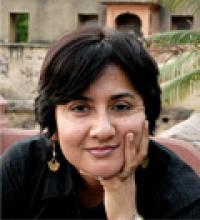
PhD Cinema Studies, School of Arts and Aesthetics, JNU
MFA: Performance Studies – Film, University of Wisconsin-Milwaukee
MA: Mass Communication – A.J Kidwai Mass Communication Research Centre, Jamia Millia Islamia University
BA: Political Science Honours – Lady Shri Ram College, University of Delhi
Music, Sound and Voice in Cinema; Media Archaeology; Digital Cultures, Regional Cinema, Production Culture
Teaching at the School of Arts and Aesthetics since October 2015
Teaching at the Department of Journalism, Lady Shri Ram College, University of Delhi from 2006-2015
International Visiting Fellow at the Grinnell College to teach a short term course in February 2019.
Independent Documentary Filmmaker 1986 - 2005. Documentaries with role as a director include Health Matters, 2005; Born to Sing, 2001; Living Through Performance, 1997; The Power of the Image, A Television Series on Bombay Cinema (1998), The Hidden Story (1995) and Prisoner of Gender which won the Silver Panda second prize at an International Documentary Festival in China (1991).
Awarded Travel Grant by Delhi University Research Council to attend Moving On: South Asian Screen Cultures in a Broader Frame, an international conference at Westminster University, (2014).
Awarded Habeeb Kidwai Research Fellowship by the Media Resource Centre, AJ Kidwai Mass Communication Research Centre for a research project on Teenaged Girls and Global Television (2010).
Awarded FOKUS grant by International Association for Women in Radio and Television for a study on the History of the Female Voice in Hindi Film Songs (2006).
Awarded Artists Residency Fellowship to attend and participate in the Adelaide Arts Festival by Australian Cultural Residency to pursue a project on Digital Documentary Practice (2002). Ten International artists were chosen for this residency.
Recipient of a grant from the IGNCA (Indira Gandhi Centre for Culture and Arts) to produce and direct a documentary on the songs of the Mirasans of Punjab (2000).
Recipient of Majlis Research Fellowship for a study on the Mirasans and the wedding songs of Punjab (1999).
Founder member of Mediastorm, India’s first women’s film collective which received the Chameli Devi Jain Award for outstanding women media professionals in 1992.
Co-investigator of EQUIP-ICSSR (EU-India Social Sciences and Humanities Platform) Research Project ‘FilmInd: The Indian film industry as a driver of new socio-economic connections between India and Europe’. This is a joint collaboration between Cinema Studies (CNS), School of Arts and Aesthetics, JNU, India; University of Basel, Switzerland; Novia University of Applied Sciences, Finland; the Slovenian Academy of Sciences and Arts and Adam Mickiewicz University, Poznan, Poland – 2018 to present.
Served as a Secretary at the Board of International Association of Women in Radio and Television, Chapter India from 2022 to 2022.
Volatile Scales, Contingent Bodies: The Many Voices of Asha Bhosle, in Neepa Majumdar and Ranjani Mazumdar (Eds.), Companion to Indian Cinema, Wiley Blackwell, 2022, 241-261.
The Textual, Musical and Sonic Journey of the Ghazal in Bombay Cinema, in Ira Bhaskar and Richard Allen (Eds.), Bombay Cinema’s Islamicate Histories. Orient BlackSwan, 2022, 229-258.
Film Music, in The Keywords Issue. Bioscope: South Asian Screen Studies, 12 (1-2), 2021.
Sonic Ruptures: Music Mobility and the Media in Arvind Rajagopal and Anupama Rao (Eds.), Media and Utopia: History, Imagination and Technology, Routledge, 2016, 209-234.
Backpacking Sounds: Sneha Khanwalkar and the “New” Soundtrack of Bombay Cinema in Feminist Media Histories, 1 (4), 2015, 71-88.
Teenaged Girls and Global Television: Performing the New Hindi Film Song in Susan Dewey and Karen J. Robinson (Eds.), Super Girls, Gangstas, Freeters & Xenomaniacs: Gender and Modernity in Global Youth Cultures, Syracuse University Press. 2012, 125-144.
Lata Mangeshkar’s Voice in the Age of Cassette Reproduction in Bioscope: South Asian Screen Studies, 4 (2), 2013, 97-114.
Re-embodying the 'Classical': The Bombay Film Song in the 1950s in Bioscope: South Asian Screen Studies, 2 (2), 2011, 157-179